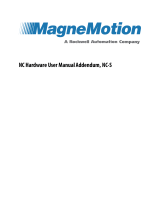
IA261/262 WinCE User’s Manual Introduction
Product Software Specifications
IA261/262 WinCE ready-to-run embedded computers are network centric / head-less computers
that are designed to be programmable for embedded communication applications. The following
are the software features of IA26X-CE:
Applications Development Environment
To make IA26X-CE an easy-to-use programming environment, its Windows® CE environment
provides the following common, popular application development features that make
programming convenient and easy as in a PC environment.
y C Libraries and Run-times - Compared to the C libraries and run-times used on a desktop
PC running Windows®, the C libraries and run-times on a IA26X-CE is a subset of the
WIN32 APIs. It supports full ANSI C run time, standard input/output library, standard
input/output ASCII library and standard ASCII string functions. In addition, it supports
compiler C++ exception handling equivalent and Run-Time Type Information (RTTI)
equivalent to the desktop C++ compilers.
y Component Services (COM and DCOM) - The Common Object Model (COM) is an
operating system-independent, object-oriented system for creating binary software
components that can interact with other COM-based components in the same process space, in
other processes, or on remote machines.
y Microsoft® Foundation Classes (MFC) - MFC is a comprehensive class library and
complete object-oriented application framework designed to help build applications, COM
components, and controls.
y SOAP Toolkit - SOAP is an XML-based protocol for object exchange and remote procedure
calls. Microsoft® Windows® CE 6.0 provides functionality similar to the SOAP Toolkit
version 2 on the desktop. It provides a layer that allows COM objects to use SOAP as the
transport protocol for remote procedure calls and to interact with Web services.
y Microsoft® .NET Compact Framework 2.0 with service pack 2 - It offers a choice of
languages, initially Microsoft® Visual Basic® and Microsoft® Visual C#, and eliminates the
common problems faced with language interoperability.
y XML- Provides the Document Object Model (DOM) for base XML functionality, support for
XML Query Language (XQL) and XPATH, Extensible Style Sheet Language
Transformations (XSLT) that enables you to transform one class of XML document to another,
SAX2 support for event-based parsing of XML documents and includes MSXML Writer, and
parsing based on Simple API for XML (SAX) for resource-constrained target devices.
y Winsock 2.2 - Provides enhanced capabilities over Winsock 1.1, including installable service
providers for additional third-party protocols, as well as Media sense.
Networking and Communications Capabilities
For network centric embedded application usage, IA26X-CE, not only provides powerful
communication hardware interfaces including dual Ethernet and 3-in-I serial ports, but also
supports the networking and communications capabilities that are built-in to Windows® CE 6.0
OS. The features that are well supported are listed as below.
y Simple Network Management Protocol (SNMP) - Monitors remote connections to the
network.
y Simple Network Time Protocol (SNTP) Client - Provides support for synchronizing the
device’s system time with a SNTP server, and supports Daylight Saving Time.
y Serial Communications - In addition to the 16550 UART driver bound to a debug port and
the console port, it includes a special driver for 8 additional Moxa home-made serial ports.
1-6
























